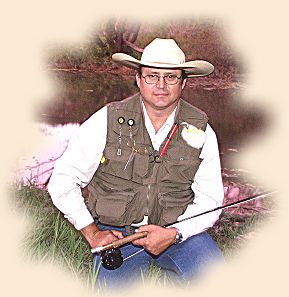Ever been out fishing for the big Blue Gills, Shellcrackers or
some other panfish only to get hit time and time again by the
little fish? How about as you are pulling in one of those little
fish, you notice a large hump of water forming behind it. Now you
have a severely panicked panfish being chased by, at this point
who knows what. At some point the larger fish slams the smaller,
your rod tips does a deep bow towards the water and thenů nothing.
The larger fish has pulled off the smaller sometimes along with
your fly. In most cases this larger fish is a bass. In our
rivers and creeks these fish can become fairly large and very
aggressive. I used to only use 4 pound tippet/leader, however
from so many lost fish, I will not use anything less than 6 pound.
I once saw a fellow fly fisher who after losing two small fish
and flies to an unknown assailant, tied on a large black woollybugger
lost it to the unknown denizen just as easily. No fight or any
real movement from the fish. Just a sharp tug and the fish and
flys were gone. At this point he returned to his car and put
together his 8 Wt. With 20 pound "Fireline" as the leader and the
largest perch imitator I have ever seen. Now I'm really intrigued.
I stop fishing and take a seat on the bank. On the third cast
while stripping it back he felt it snag something. While he was
trying un-snag it, the "snag" moved! It was a tug-of-war for
a while but the assailant in this case turned out to be a 30.75
inch flathead catfish. Most people believe catfish are bottom
feeding scavengers. Flatheads are aggressive predators and
actively feed on small bream. I have actually, and completely
by surprise, caught flatheads and channel cats on top-water flies
but only in rivers and creeks. Neither were very big, but they
were strong fish.
Of course there is always the scenario of where you are using a
small fly for blue gills only to have repeated strikes from bass,
with the hook being too small, the bass repeatedly shake it lose.
There is a place where I and Rob, a good friend of mine, frequent.
It has a excellent population of bream and I have landed some fairly
nice ones there. One day I as usual was specifically fishing for
bream but was being constantly harassed by the bass and using a size
14 spider was losing most of the bass that were hitting my fly. Rob
having observed this for as long as he could stand it, came over and
offered to "rescue" me from the bass plague. Rob has caught some
really nice bass anywhere up to 23 inches long from that hole.
When he goes alone, he usually calls me to report on catching
another large bass. I think I'll start tagging the bass. I
think it's the same one each time he goes. But I wont tell.
Whenever I'm fishing for panfish and I run into the above situations,
I'll switch over to some sort of bass bug to see if I can entice it
to strike. One thing I do know, bass love frogs. There are a lot
of Frog flys out there, (does that border on an oxymoron?) Some are
quite detailed and require time and patience to tie. For me two
strands white of Krystal Wing Fiber, a green pom pom, a white pom
pom and I'm good to go! This is a relatively simple fly to tie and
I can usually build one in about 5 minutes on a good day (providing
my fingers don't get glued together or to the frog). I never start
out using this fly, only after I know there is a large bass actively
feeding in a given area. It has been an excellent fly for our river
bass.
The Pom Pom Frog
Materials:
1. Hook: Orvis 8810 Size 2.
2. Thread: Black 6/0.
3. Body: (1) 1 inch Green and (1) 1 inch White Pom Pom.
4. Legs: Krystal Wing Fiber, White.
Instructions:
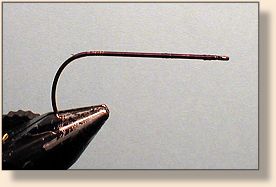
1. Wrap a solid thick bed of thread. This becomes the main
anchor point for the frog body halves.
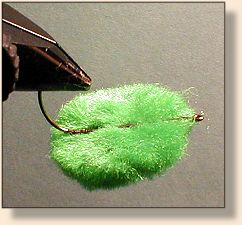
2. Trim and flatten the green pom pom then place it on the top
side of the hook. Note: Having a rotary vise can be an
advantage, rotate the hook until it's upside down and then you
can easily ensure the correct placement of the pom pom.
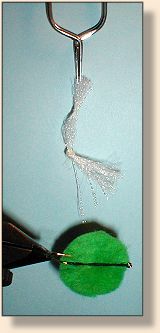
3. Take a section of the Krystal Wing Fiber and put a knot in
the middle. Trim one side of the knot to no longer then the
pom pom diameter. This will be the foot. The other side can
be as long as you deem necessary. Make sure the length is correct!
There is no trimming after the next steps.
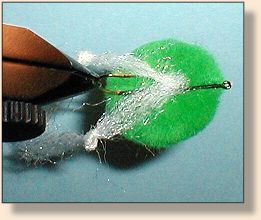
4. Place the legs in one of two positions, feet facing out from
frog body centerline or in towards body centerline. Place the
non-feet side of the knot of each leg in a "Vee" from the rear
of the body to where the point meets in the center of the hook
shank length. Glue legs in place with Zap-a-Gap.
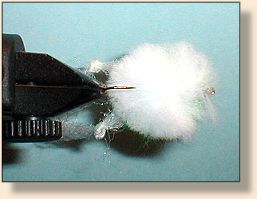
5. Trim and flatten the white pom pom. Glue to the hook and
bottom of the green pom pom.

6. At this point the fly is complete but rough looking.
(Green/white Star Trek Enterprise?)
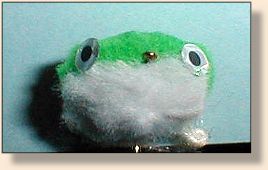
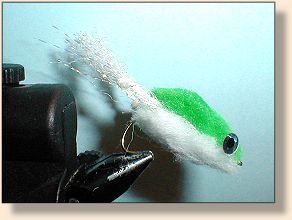
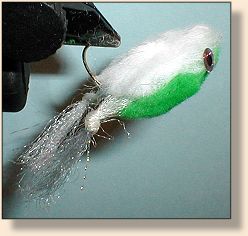
7. Trim add eyes and the frog is ready.
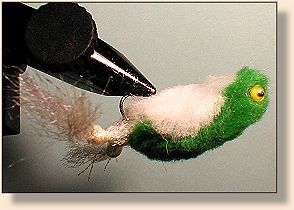
Variations in eyes and body style including all white pom poms
to color match local frogs is just as simple. ~ Hillfisher
|

